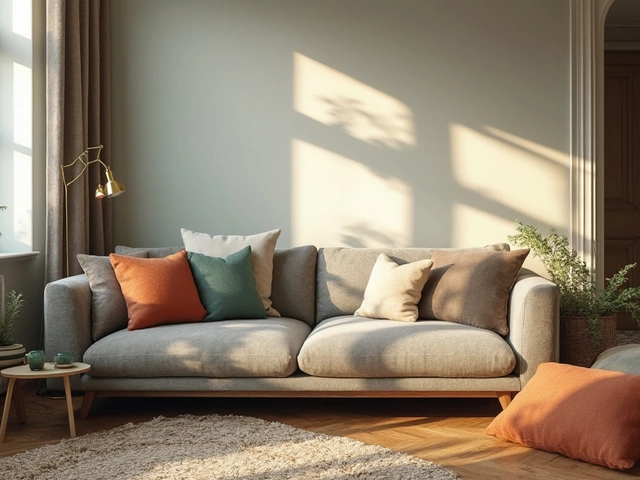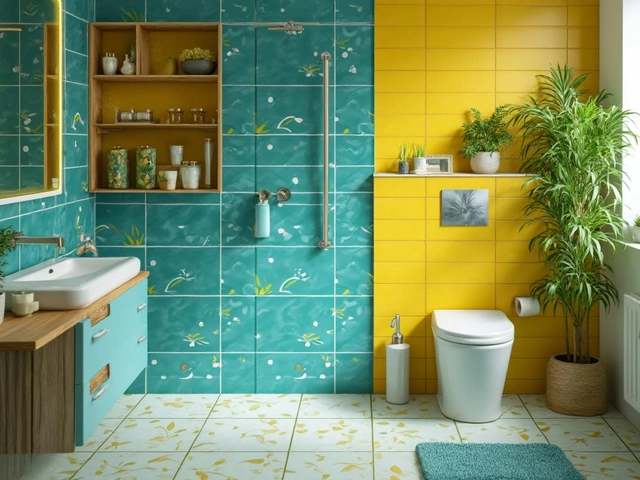How Many Inches Should Curtains Be Off the Floor? Perfect Hanging Lengths Explained
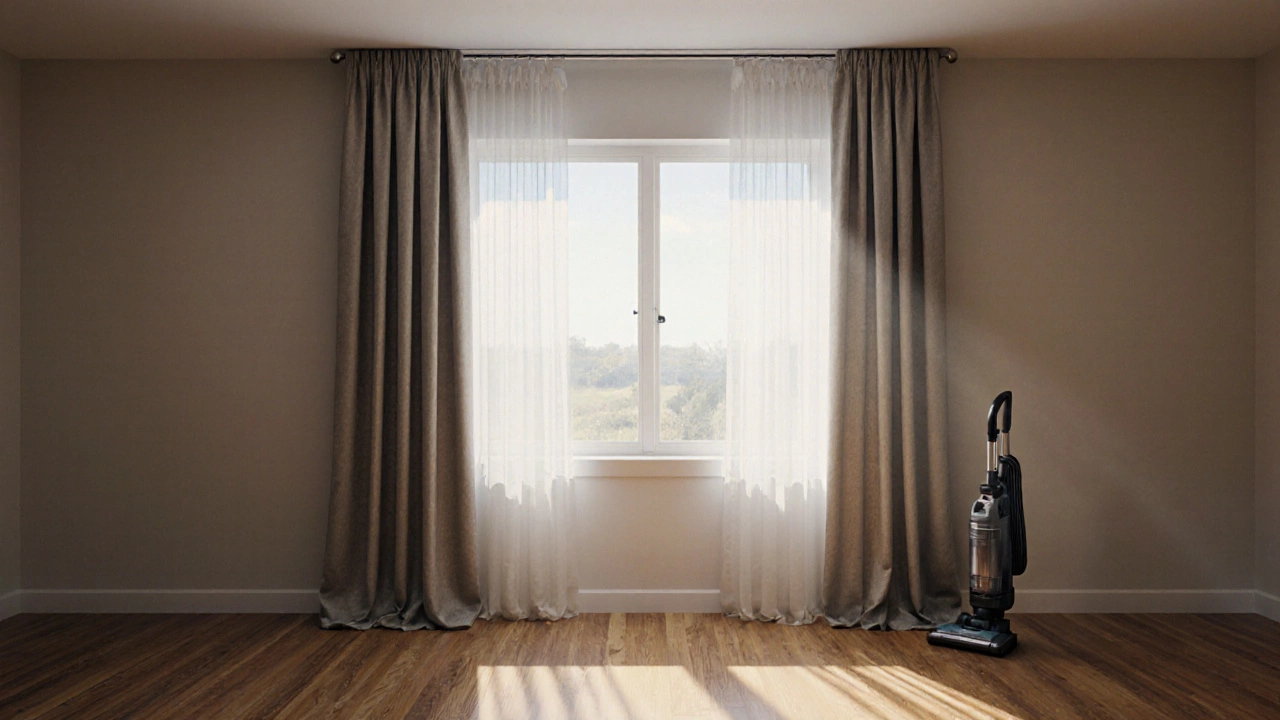
Curtain Length Calculator
Calculate Your Perfect Curtain Length
Enter your measurements and preferred style to get the ideal curtain length for your space.
Measurements
Style Preference
Your Result
Enter your measurements and select a style to see your result.
Getting curtain length right isn’t just about looks-it affects how your room feels, how easy it is to clean, and even how much light gets in. Too long, and your curtains drag like muddy shoes. Too short, and they look like they’re running away from the window. So how many inches should curtains be off the floor? The answer depends on the style you want, the type of floor, and whether you care more about function or fashion.
Standard Curtain Length: 1/2 Inch Above the Floor
The most common and practical choice is to have curtains hang 1/2 inch above the floor. This is the gold standard for a clean, tailored look. It keeps the fabric from collecting dust, pet hair, or water splashes, especially near entryways or in kitchens. It also makes cleaning easier-you can vacuum or mop right up to the edge without having to lift or adjust the curtain.
This length works best with rod-pocket or tab-top curtains, and it’s ideal for homes with hardwood, tile, or laminate floors. If you’re using a curtain rod mounted above the window frame, this small gap creates a subtle illusion of height without looking unfinished. Many interior designers swear by this rule because it’s timeless, low-maintenance, and never looks sloppy.
For a Luxe Look: Brushing the Floor
If you’re going for a more dramatic, high-end vibe-think hotels, luxury apartments, or formal living rooms-let your curtains just lightly brush the floor. This means the bottom hem touches the surface with no gap, but doesn’t pool or bunch up. You’re aiming for about 0 to 1/4 inch of contact.
This style works best with heavier fabrics like velvet, linen blends, or blackout curtains. It adds weight and elegance to the space. But be careful: if your floor isn’t perfectly level, or if you have a rug underneath, the fabric might catch or wear unevenly. This look also requires more frequent cleaning, especially in homes with pets or kids. Still, if you want that rich, draped effect, brushing the floor is the way to go.
Pool Curtains: The Dramatic (But Risky) Choice
Some people love the theatrical look of curtains that pool on the floor-meaning they extend 2 to 6 inches beyond the floorline, creating soft folds or puddles of fabric. This is common in Victorian-style homes, theaters, or high-end showrooms.
But here’s the catch: pooling curtains are high-maintenance. They collect dust, trap moisture, and can be a tripping hazard. They also make cleaning underneath nearly impossible without moving the curtain each time. Unless you’re going for a very specific, intentional design statement, this style is rarely worth the hassle in everyday homes. If you do choose it, use only lightweight, non-slip fabrics like chiffon or silk, and avoid high-traffic areas.
What About Windows Above Baseboards?
If your window sits right above the baseboard (common in older homes or modern minimalist designs), you have two options: either hang the curtain so it ends just above the baseboard, or let it hang down to the floor, covering the baseboard entirely.
Most experts recommend covering the baseboard. Why? It creates a continuous vertical line that draws the eye upward, making the ceiling feel higher. A curtain that stops at the baseboard can make the wall look chopped off, especially if the baseboard is wide or ornate. If you’re unsure, try taping a piece of fabric to the rod and stepping back. Does it feel balanced? Or does it look like something’s missing?
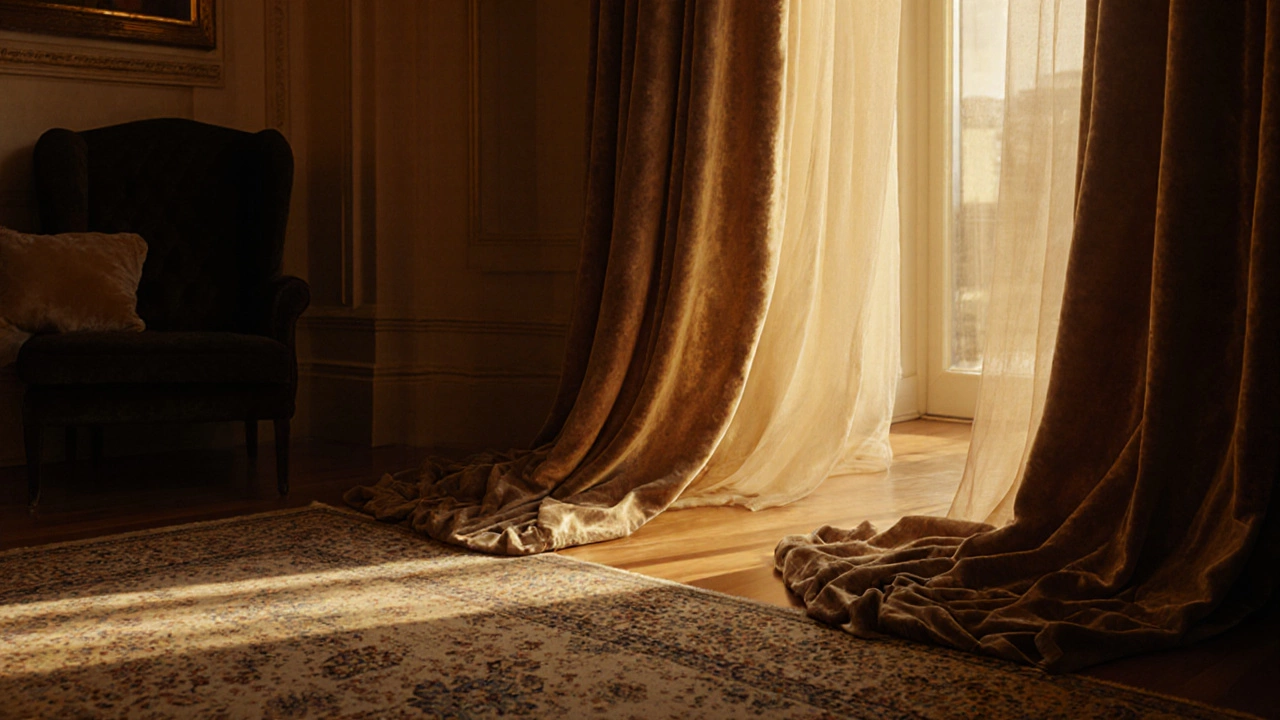
How to Measure Correctly
Here’s a foolproof way to get the right length every time:
- Install your curtain rod. Make sure it’s level and mounted at least 4 to 6 inches above the window frame for maximum height illusion.
- Measure from the bottom of the rod to the floor. Use a metal tape measure-cloth tapes stretch and give wrong readings.
- Subtract the amount you want off the floor: 1/2 inch for standard, 0 for brushing, or 2-6 inches for pooling.
- Order or cut your curtains to that exact length.
Don’t rely on store labels like “96-inch curtains.” Those are approximate. Actual drop lengths vary by brand and fabric. Always measure your own space.
Special Cases: Rugs, Sliding Doors, and Bay Windows
If you have a rug under the window, aim to have the curtain just touch the edge of the rug. This ties the window treatment to the floor and keeps the room feeling unified. If the rug is small and centered under the window, let the curtain hang to the floor anyway-it creates a stronger visual anchor.
For sliding glass doors, you’ll want the curtain to reach the floor without dragging. A 1/2 inch gap is perfect here too. But if your door opens outward, make sure the curtain doesn’t get caught in the track. Consider using tiebacks or magnetic clips to hold them back.
With bay windows, measure each section separately. Curtains on the center panel might hang longer than the side panels. To keep things balanced, either make all panels the same length (hanging to the floor) or let the side panels stop at the baseboard. Never let one panel pool while another is short-it looks accidental, not intentional.
Why This Matters More Than You Think
People don’t realize how much curtain length affects perception. Curtains that are too short make ceilings look lower. Curtains that drag make a room feel cluttered. The right length makes a space feel intentional, calm, and put-together-even if the rest of the decor is simple.
Think of it like shoes: you wouldn’t wear socks with sandals in winter, and you wouldn’t wear flip-flops to a job interview. Same goes for curtains. The length tells people whether you care about details. It’s the finishing touch that turns a good room into a great one.
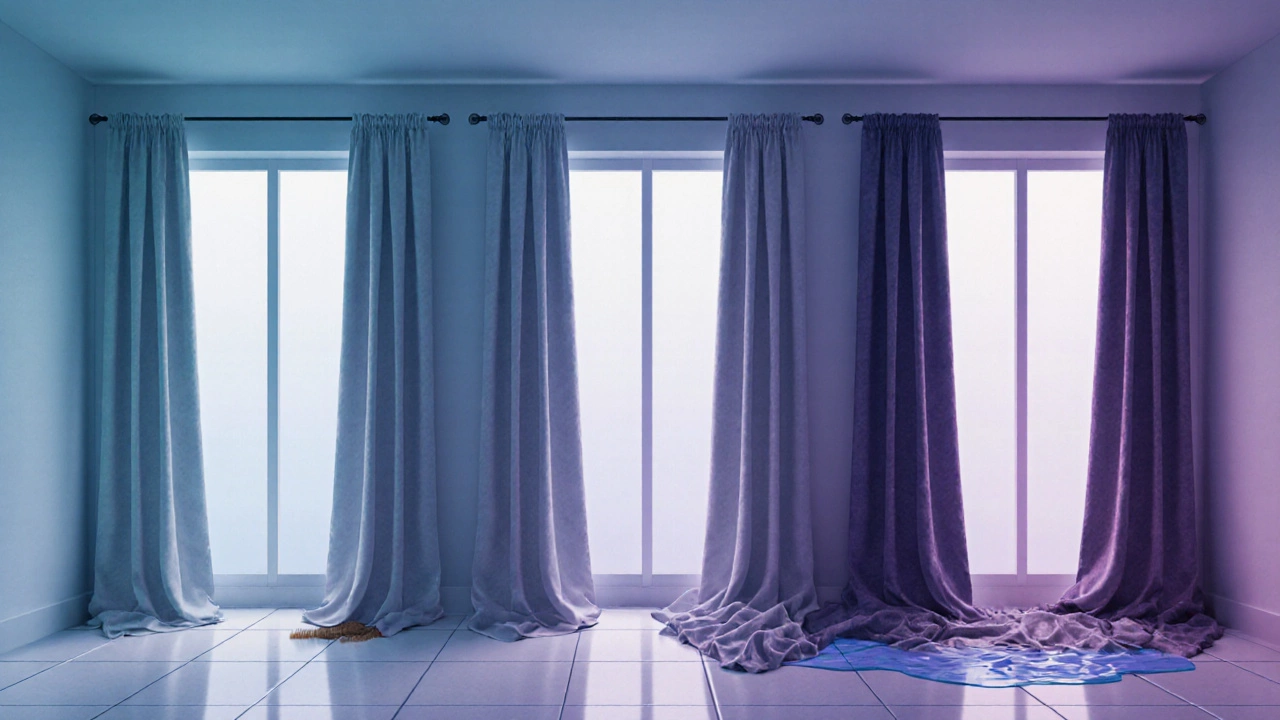
Common Mistakes to Avoid
- Buying curtains off the rack without measuring your window. Most stores sell standard lengths, and yours might not match.
- Hanging the rod too low. Mounting it close to the ceiling creates the illusion of taller ceilings.
- Ignoring the floor type. Carpet needs different treatment than tile. Thick pile can hide a 1-inch gap, but polished concrete won’t.
- Using the same length for all windows in the house. Kitchens might need shorter curtains; living rooms can handle floor-length.
- Forgetting to account for hardware. If you’re using rings or clips, they add 1 to 2 inches of drop. Measure from the rod to the floor, then subtract your desired gap.
What If Your Curtains Are Too Long?
If you already bought curtains that are too long, don’t panic. You can hem them yourself with a needle and thread or a sewing machine. Use a blind hem stitch for a nearly invisible finish. Or, if you’re not handy with a needle, take them to a tailor or dry cleaner-they often do this for under $20.
Another quick fix? Use curtain clips or tiebacks to lift the bottom hem slightly. It’s not perfect, but it works in a pinch.
What If Your Curtains Are Too Short?
Short curtains are harder to fix. You can add fabric panels to the bottom, but matching color and texture is tricky. The best solution? Replace them. Look for curtains labeled “floor-length” or “96-inch” and measure twice before buying.
And remember: if you’re shopping online, check the product description for the actual drop length-not just the label. Some brands list the rod-to-floor measurement, others list the panel length. Confusing? Yes. Common? Also yes.
Should curtains touch the floor or hover above?
For most homes, curtains should hover 1/2 inch above the floor. It’s practical, clean, and looks intentional. If you want a more luxurious look, let them lightly brush the floor-but avoid pooling unless you’re going for a dramatic, high-maintenance style.
Do I need to measure the curtain rod or the window?
Always measure from the bottom of the curtain rod to the floor. The window frame doesn’t matter-what matters is where the curtain hangs. Most rods are installed above the window to create height, so your measurement should reflect that.
Can I use the same curtain length in every room?
You can, but it’s not always ideal. Kitchens and bathrooms often look better with curtains that stop above the sink or counter. Bedrooms and living rooms benefit from floor-length curtains. Match the length to the function of the room, not just the style.
What if my floor is uneven?
If your floor slopes or has a step, measure at the lowest point. That way, your curtain won’t catch or drag on the higher side. You can also have the hem adjusted to follow the slope slightly-this is called a “lived-in” hem and works well in rustic or eclectic spaces.
Do blackout curtains need different lengths?
No, blackout curtains follow the same rules. But because they’re usually heavier, they’re more likely to pool if too long. Stick to 1/2 inch above the floor or a light brush. Avoid pooling-it makes them harder to open and close smoothly.

